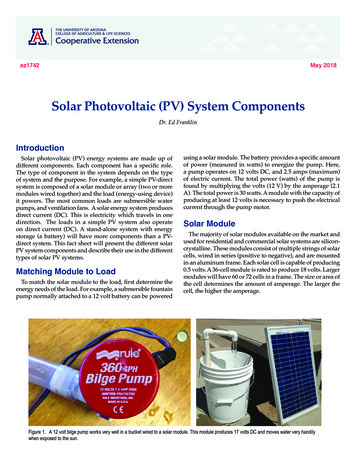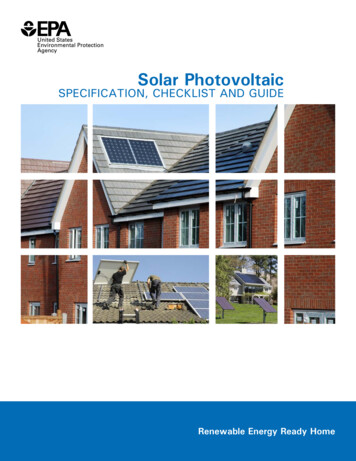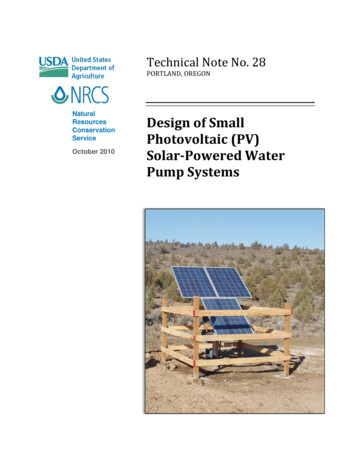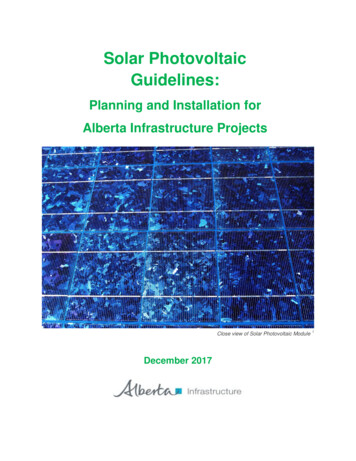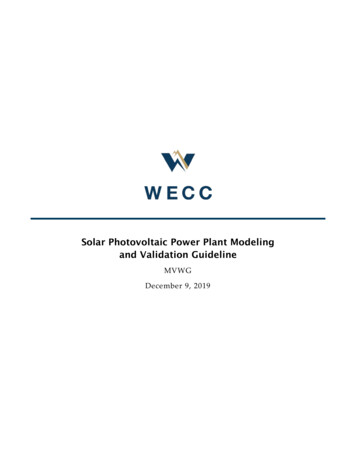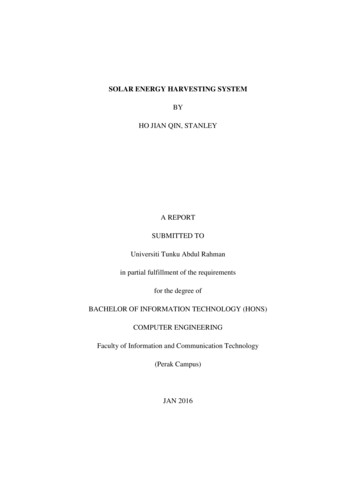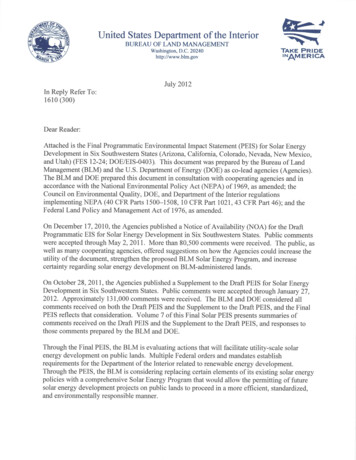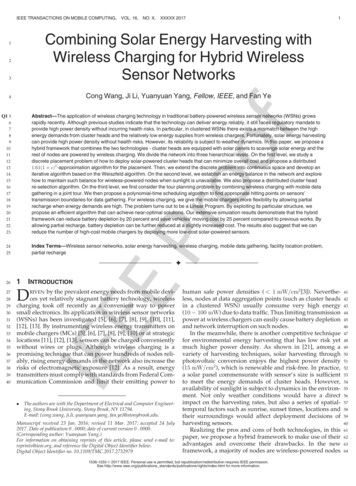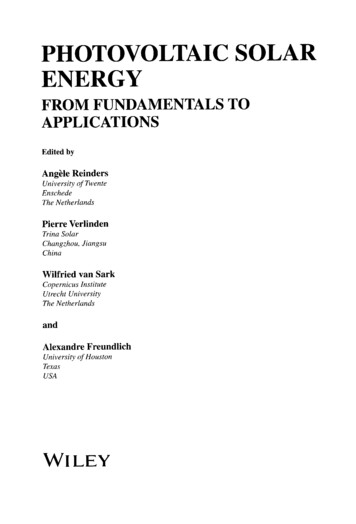
Transcription
PHOTOVOLTAIC SOLARENERGYFROM FUNDAMENTALS TOAPPLICATIONSEdited byAngeleReindersUniversity ofTwenteEnschedeThe NetherlandsPierre VerlindenTrina SolarChangzhou, JiangsuChinaWilfriedvanSarkCopernicus InstituteUtrechtUniversityThe NetherlandsandAlexandre FreundlichUniversity of HoustonTexasUSAWiley
ContentsList of About theWilfriedReinders,vanSark, and Pierre Verlinden1.1.1Introduction to Photovoltaic Solar1.1.2of IrradianceProperties1.1.2.1Photons1.1.2.2Solar raction, Reflectionand Transmission81.1.3Structure of the Book10List ofSymbols11Constants11List of Acronyms11References11BASIC FUNCTIONAL PRINCIPLES OF PHOTOVOLTAICSPart Two2.1xxxvINTRODUCTION TO PHOTOVOLTAICSPart One1.1WebsiteCompanionSemiconductor Materials and theirAngeleReinders2.1.1Semiconductor MaterialsPropertiesStructures of Semiconductors131515162.1.2Crystalline2.1.3Energy Bands in Semiconductors17List ofSymbols19List of Acronyms19References20
viiiContents2.2Doping, Diffusion,and Defects in Solar Cells21Pierre J. Verlinden2.2.1Introduction2.2.2Silicon Wafer 2.2Purification of Silicon2.2.2.3Silicon FeedstockSilicon222223Ingot Formation2.2.3.123Mono-crystalline IngotsMulti-crystalline IngotsSlicing2.2.3.22.2.3.32.2.4Doping2.2.5Defects in Silicon2.2.5.1232526and Diffusion2.2.5.2Point DefectsLine Defects2.2.5.3Planar Defects2.2.5.4VolumeList ofSymbolsList rption31and Generation32Seth Hubbard2.3.1Introduction2.3.2Generation of Electron Hole Pairs in togenerationCoefficient for Direct and 2.433BandgapRecombinationSeth Hubbard2.4.1Introduction2.4.2Radiative Recombination2.4.3Auger -Hall) RecombinationSurface, Interface and Grain Boundary RecombinationReferences2.5CarrierTransportSeth Hubbard2.5.1Introduction2.5.2Drift Current2.5.3Diffusion Current2.5.4Total 14244464747474950
ixContents2.5.52.5.62.5.750Quasi-Fermi Levels and CurrentContinuity EquationsMinority Carrier Transport Equations515253References2.6PN Junctions and the Diode54EquationSeth sList of SymbolsList of Acronyms63References66Part Three3.1Properties of a pn HomojunctionIdeal pn Diode in the DarkDepletion Region Effects and the General Diode636567CRYSTALLINE SILICON TECHNOLOGIESSilicon Materials: Electrical and69Optical PropertiesAndreas Fell3.1.1Introduction3.1.2Electrical3.1.4List ofList of703.1.2.2PropertiesBandgap and IntrinsicBandgap Narrowing3.1.2.3Carrier Statistics723.1.2.4Mobility723.1.2.5Intrinsic ockley-Read Hall (SRH)DefectRecombination743.1.2.7Metal743.1.2.8SRH via74ImpuritiesComplexesOptical Properties3.1.3.1Complex Refractive Index n ik of Intrinsic3.1.3.2Free Carrier Absorption 8References3.270Density80Silicon Solar Cell Device StructuresAndrew Blakers andNgweZin3.2.1Introduction803.2.2Solar Cell813.2.3Minimizing Electron-Hole Recombination823.2.4MinimizingElectrical Losses833.2.5Screen-Printed Silicon Solar Cells833.2.6Selective Emitter Solar Cells843.2.7PERC and PERL Solar rates86
XContents3.2.9N-Type Rear Emitter SiliconSolar Cells3.2.10N-type Front Emitter SiliconSolar Cell3.2.11Efficiency Improvements3.2.12Conclusion3.2.11.18687for Industrial Solar CellsPassivation Schemes for88Boron-Doped Emitter8889References3.390Interdigitated BackContact Solar Cells92Pierre Verlinden3.3.1Introduction3.3.1.192ADifferent Concept for High-Efficiency SiliconDifferent Types of IBC Solar Cells3.3.2.1Front Surface Field Solar Cells3.3.23.3.3FrontPoint-Contact Solar Cells3.3.2.497IBC Solar Cells for ConcentratorApplication97FloatingEmitter Solar CellsSymbolsof AcronymsBasic Principles3.4.2a-Si:H/c-Si Cell3.4.3KeyCells104105Development107Issues in a-Si:H/c-Si Cells3.4.3.1108Surface PassivationWafer Cleaning3.4.3.21081093.4.3.3TexturingAdvantages Compared110to c-SiCells110List ofSymbolsof Acronyms110111References3.5112Surface Passivation and Emitter RecombinationParametersBram Hoex3.5.1Introduction3.5.2Surface Passivation Mechanisms3.5.2.13.5.2.3Used SurfacePassivating(SiNJ3.5.3.1Silicon Nitride3.5.3.2Silicon Oxide (SiO )Aluminum Oxide (AlOJ3.5.3.33.5.3.43.5.4Passivation of Diffused SiliconCommonlyTitanium OxideConclusion(TiOJ114114Chemical and Field-Effect PassivationPassivation of Undiffused on Silicon SolarWilfried van Sark3.4.496101References3.495953.3.2.2List ofList923.3.2.3IBC Solar Cells for One-Sun Flat-Plate ModulesConclusion3.3.4Solar 120121
xiContentsList ofList of3.6121SymbolsAcronyms122References122Passivated Contacts125Martin Hennle1253.6.1Introduction3.6.2Theory of Passivated Contacts3.6.3ExperimentallySilicon ctor (CIS) Based130Contacts3.6.4Conclusion133List ofSymbolsAcronyms133List of133References134Light Management in Silicon Solar CellsZachary Holman and Mathieu Boccard1363.7.1Introduction1363.7.2Theory and1373.7.3Front-Surface ptionLight Trapping1453.7.6Conclusion147List ofSymbolsAcronyms148List of3.81281293.6.3.1Passivated3.7126Realized Passivated Contacts147References149Numerical Simulation of Crystalline Silicon Solar Cells150Pietro l Simulations?WhyCommonlyUsed Software for the Numerical Simulation151of Si Solar Cells3.8.4General Simulation Approach3.8.5Detailed Numerical Simulation of3.8.6ConclusionAdvancedmc-Si Solar Cell155156158References3.9153anConcepts160Martin Green3.9.1Introduction1603.9.2Near-Term .9.4Conclusion165163List of Acronyms166References166
xiiContentsPart Four4.1CHALCOGENIDE THIN FILM SOLAR CELLSBasics ofChalcogenideThin Film Solar Cells167169Susanne Siebentritt4.1.1Introduction4.1.2The Electronic Structure of Thin Film Solar CellsThe Current-Voltage Characteristics of Thin Film4.1.3169Solar Cells4.1.4ConclusionList ofSymbolsAcronymsList of173175176176References4.2176Cu(In,Ga)Se2 and CdTe AbsorberSylvain MarsillacMaterials and their Properties4.2.1Introduction4.2.24.2.3Structural PropertiesPhase Diagram4.2.4Electronic Properties and Defects4.2.5List ofOptical PropertiesSymbolsList ratesand Interfaces1901901904.3.2.1Glass Substrates1914.3.2.2Flexible Substrates4.3.2.3192Metallic Substrates1924.3.2.4Polymer193SubstratesBack Contact1934.3.3.1Mo Back Contact1934.3.3.2Alternative Back Contacts1934.3.3.3Nanostructured Back Contact1944.3.3.4MoSe2 Interface LayerFront-Contact4.3.4.1LayersBuffer Layers1951951954.3.4.24.3.5Front Contact and Window LayersConclusion198List ntacts, Buffers, Substrates,Negar Naghavi4.3.3179179References4.3170CIGS man4.4.1Introduction4.4.2DepositionProcesses and204Equipment205
xiiiContents4.4.3Module Fabrication2074.4.4Cost and Materials2094.4.5Conclusion and Future Considerations211List ofAcronyms211211ReferencesTHIN FILM SILICON-BASED PV TECHNOLOGIESPart Five5.1Amorphous213Nanocrystalline Silicon Solar CellsSchtittauf and Christophe Ballifand215Etienne Moulin, Jan-Willem5.1.1Introduction2155.1.2Amorphous and Nano-Crystalline Solar Technology2165.1.2.1General Aspects5.1.2.2Key Technological Steps Towards Highest Efficiencies216in Research and Production5.1.2.3217Unique Potential for Up-scalability of the a-Si:H5.1.4and nc-Si:H TechnologyPoly-crystalline and Mono-crystalline SiliconPerspectives for Thin Silicon Solar Technology2195.1.5Conclusion222List n220CrystallineSilicon Solar CellsonGlass226Onno Gabriel, Daniel Amkreutz, Jan Haschke, Bernd Rech,andRutgerSchlatmannIntroduction5.2.2Solar Cells BasedonLiquid-Phase CrystallizedSilicononGlassSources for LPCEnergy5.2.2.2Substrates, Interlayer and Absorber DepositionChemical and 2.2.35.32265.2.1PropertiesSilicon Absorbers2302312325.2.3Cell Concepts for Thin5.2.4Future Outlook2345.2.5Conclusion234AcknowledgmentsList of Symbols and Acronyms235References236Light Management in Crystalline235and Thin Film Silicon Solar Cells238Franz Haug2385.3.1Introduction5.3.2Light Scattering5.3.3Parasitic Losses2425.3.4Conclusion244List ofSymbolsAcronyms244List ofReferencesInterfaces240245245
xiv5.4ContentsNew FutureJan-WillemConceptsSchuttauf, Etienne Moulin,248andChristophe Ballif5.4.1Introduction5.4.2Thin Film SiliconTriple-Junction5.4.3Thin Film SiliconQuadruple-Junction5.4.45.4.5Further Improvements in Thin Film Crystalline Silicon Solar CellsConclusionList ofSymbols248Solar CellsSolar Cells6.1251252253ORGANIC PHOTOVOLTAICSSolid-State250253ReferencesPart Six249255Organic Photo voltaics257Bernard 6.1.46.1.6Organic SemiconductorsProcessing of Organic SemiconductorsPhysics of Organic Solar Cells6.1.7261State-of-the-Art and Current idandWoojunYoon265Dye-SensitizedSolar Cells6.2.1Introduction6.2.2Current Status ofHybrid6.2.3Hybrid QuantumDot Solar Cells6.2.4Silicon-Organic Hybrid e-SensitizedSolar Cell PerformanceCellsSolar Cells275275Perovskite Solar CellsSamuel D. Stranks and277HenryJ. Snaith6.3.1Introduction6.3.2Organic-Inorganic 7for PhotovoltaicsTunability of the Crystal Structure6.3.2.2Evolution from Dye-Sensitized Solar Cells6.3.2.3Emergence of a New Thin Film TechnologyDeposition Methods6.3.3.1One-Step Depositions6.3.3.2Two-Step Depositions277111278280280281281
Contents6.3.4xvOperationSystems6.3.4.2Electronic Properties6.3.4.3Device OperationOngoing Challenges6.3.5.1Lead-free Alternatives6.3.5.2Hysteresis6.3.5.3Thermal and Operational Stability282Conclusion288Enabling 4Module Design ion2926.4.1.1From Cells to Modules292Advantages of R2R Production6.4.1.3Module Design for Organic PVImportant Module Parameters2936.4.2.1Cell Size2956.4.2.2Series Connection2956.4.2.3BarrierRequirementsWet Processing Technologies6.4.3.1Slot-Die Coating6.4.3.2Inkjet Printing6.4.3.3Spray Coating6.4.3.4Other Techniques and Comparisons295Interconnections2996.4.4.1Tiled Coating3006.4.4.2In-Process Scribing3006.4.4.3Back-end (Laser) Processing3002932952962972972972986.4.5Future Outlook301List ofAcronyms301302ReferencesPart Seven7.1284Gevaerts6.4.1.26.4.2283289Organic PVVeronique S.6.4.1282CHARACTERIZATION AND MEASUREMENTS METHODSMethods and Instruments for the Characterization of Solar Cells303305Halden antum Using Reflectance Data to Determine Internal Quantum EfficiencyAlternative Optical Configurations, Components, and FeaturesQE Measurement DataDetermining Solar Cell Current for a Particular Light Source3077.1.2.47.1.2.57.1.2.6308308309
.1I-V Curve Introduction3117.1.3.2Illumination3117.1.3.3I-V Curve Measurement7.1.3.4I-V7.1.3.5I- V7.1.3.6Calibration7.1.3.7Comparing7.1.3.8I-V Curves for Series and Shunt Resistance Measurements7.1.4Spectral7.1.5ConclusionforI-V CurvesApparatus: Light SourcesCurve Measurement Apparatus: Temperature ControlCurve Measurement Apparatus: Electrical Measurementfrom QE and I-VMeasurements317Mismatch317318319List of320List320Symbolsof Acronyms320Photoluminescence and Electroluminescence Characterization inSilicon 1.1323Electroluminescence Versus PhotoluminescenceTheory323The Generalized Planck Equation7.2.2.27.2.3Implied .1and Excess Carrier323Density fromSpectral Luminescence 326Optical Material and Device Properties from PLQuantum Efficiency from EL7.2.3.4Quantitative Analysis of Luminescence IntensitiesLuminescence Imaging7.2.4.1PL Imaging on Bricks and Ingots7.2.4.2PL Imaging on Wafers7.2.4.3 PL and EL Imaging on Finished Solar Cells7.2.4.4 EL Imaging on Modules and Systems7.2.4.5 Inspection ofPV gments334List ofSymbols334List 13335Measurement of Carrier Lifetime, Surface RecombinationVelocity,Hennerand Emitter Recombination rier Lifetime3407.3.3Measurement of the Carrier Densities and Generation Rate3407.3.3.13417.3.3.2Photoconductance (PC)Photoluminescence (PL)341
Contentsxvii7.3.3.37.3.47.3.5Open Circuit Voltage Analysis3427.3.4.1Quasi-Steady-State (QSS) Analysis3437.3.4.2Transient Analysis343of the Surface Calculation of the Effective Lifetime344Variation344Thickness Variation3447.3.5.3Reference Wafer3457.3.5.4High InjectionScenario346Calculation of the Surface RecombinationVelocityand EmitterRecombination Current3467.3.6.1SurfaceS3467.3.6.2Emitter Recombination Current J'346RecombinationVelocityOe13.1Conclusion347List ofSymbolsAcronyms347List ntrol,and DefectMonitoring350Angus Rockett1AA7.4.2IntroductionMonitoring350of Vapor Phase Film ptical Properties3557.4.4Electrical Behavior3597.4.5Concl
List ofSymbols 101 List ofAcronyms 101 References 101 3.4 HeterojunctionSilicon SolarCells 104 Wilfried vanSark 3.4.1 BasicPrinciples 105 3.4.2 a-Si:H/c-Si CellDevelopment 107 3.4.3 KeyIssuesin a-Si:H/c-Si Cells 108 3.4.3.1 SurfacePassivation 108 3.4.3.2 WaferCleaning 109 3.4.3.3 Texturing 110 3.4.4 Advantages Comparedto c-SiCells 110 List ofSymbols 110 List ofAcronyms 111 References 112

